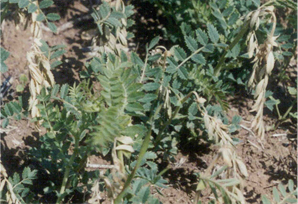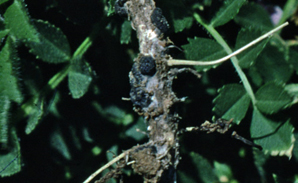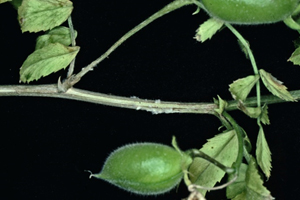Sclerotinia of chickpea
Sclerotinia (white mould) is a sporadic disease of chickpea but can cause significant crop losses, particularly in the wetter regions of eastern Australia.
The greatest losses have occurred when chickpeas were sown in areas previously cropped to crops susceptible to scleortinia, such as sunflowers.
It can be managed by using clean seed and crop rotation.

What to look for
Affected plants first wilt and rapidly die, often without turning yellow.
Later, as the plant dries out the leaves turn a straw colour. On the surface of the root, just below ground level, small black fungal bodies called sclerotia, which are irregular in size and shape, can sometimes be seen mingled with white cottony fungal mycelium.
In spring many water-soaked spots first appear on the stems and leaves. Early symptoms of stem infection appear as white mycelial growth.

Affected tissues develop a slimy soft rot from which droplets of brown liquid may exude. Infected tissues then dry out and may become covered with a web of white mycelium growth.
Disease cycle
Sclerotinia is caused by the fungus Sclerotinia sclerotiorum and S. trifoliorum.
The disease is usually established from sclerotia (survival bodies of the fungus) present in the soil or introduced with contaminated seed.

Outbreaks are most common when very wet conditions occur in mid-to-late winter (July and August). The sclerotia germinate in moist soil and either directly infect roots or produce air-borne spores which attack the above ground parts of the plant.
Once established, the fungus rapidly moves to adjacent healthy tissue. Within a few days of infection, plants start to wither then die.
Sclerotia formed on infected plants enable the fungus to survive in the soil until the following year. Individual seeds can be infected with the fungus and sclerotia may be present in the seed sample.
Soil-borne sclerotia are the more important disease source for causing damage to following crops. Seed infected with sclerotinia is the source of establishing the disease in otherwise sclerotinia-free areas.
Economic importance
Sclerotinia has caused significant crop losses where a substantial amount of the crop is infected. The disease has caused total crop failure where chickpeas were sown in the same paddock in successive years. However in many situations it only affects a small proportion of plants within the crop.
Kabuli chickpea are most susceptible to this disease though desi chickpea can also be badly affected under conditions favourable for the disease. Dense crops are likely to be affected, particularly under moist conditions.
Grain quality can be decreased when infected with sclerotinia as it causes poor colour and shrivelled seed.
Management
Use clean seed
Use of disease-free seed minimises the risk of disease and prevents establishment into a new area.
It is important to avoid sowing chickpea in areas where the disease is known to be present.
The seed harvested from infected crops should not be used for sowing.
Crop rotation
Crop rotation is the best method of control once the disease has become established.
Cereal crops are not affected by sclerotinia and provide a good disease break.
Pulse crops, oilseeds, legume based pastures and capeweed are all good hosts to this disease.
Table 1. The effect of Sclerotinia on different crops and their potential to host the pathogen Sclerotinia
CROP | Potential severity of disease on crop | Disease host |
|---|---|---|
Wheat | None | No |
Barley | None | No |
Oats | None | No |
Canola | Moderate to severe | Yes |
Safflower | Moderate | Yes |
Sunflower | Severe | Yes |
Linola | Moderate | Yes |
Field pea | Minor | Yes |
Chickpea | Moderate to severe | Yes |
Faba bean | Minor | Yes |
Lupin | Moderate to severe | Yes |
Lentil | Moderate | Yes |
Vetch | Minor | Yes |
Legume pasture | Minor | Yes |
If a severe sclerotinia problem does occur, a four year break from susceptible crops is required to substantially reduce the number of sclerotia in the soil.
The most practical option is to use cereals and legumes such as field peas or vetch which have some resistance to sclerotinia. In addition, burning of the disease infected stubble should be considered.
Deep ploughing (5cm) will also reduce the number of sclerotia, and so minimise disease carry over.
Where a minor sclerotinia problem occurs, a two year break from susceptible crops is advisable.
No commercial seed treatments or fungicides are known to manage this disease in crop.
Further references
- Pulse Australia
- National Variety Trials
- Victorian Winter Crop Summary
- Chickpea Management Package
- Winter Pulse Disorders: The Ute Guide
- Seed Health Testing in Pulse Crops
- Pulse Seed Treatments and Foliar Fungicides
Contact
Dr Joshua Fanning
Pulse Pathologist – Horsham
0419 272 075
Field Crops Pathology
Grains Innovation Park
110 Natimuk Rd
Horsham 3400
03 5450 8301
Or call the Customer Service Centre, 136 186
Acknowledgements
Trevor Bretag, Kurt Lindbeck, Helen Richardson, Kristy Hobson, Frank Henry. Support by the Grains Research and Development Corporation is gratefully acknowledged.